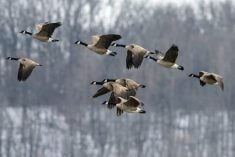What is likely a resistant variety of blackleg has destroyed 40 percent of a couple of canola fields in Manitoba.
Earlier this month, Manitoba Agriculture staff detected blackleg on the stems of canola plants on two fields. However, oilseed and plant disease specialists with the government aren’t disclosing the location of the fields or the canola variety that is infected with blackleg.
Nonetheless, the damage to the fields is extensive, said Holly Derksen, Manitoba Agriculture plant pathologist.
“To the point where plants are falling over and there’s most likely going to be a big yield loss,” she said, noting 40 percent of the canola plants in one field had fallen over because of the stem rot.
Read Also

Women who fed a nation
More than 40,000 young women supported the war effort between the 1940s and early 1950s, helping grow and harvest crops amid labour shortages. They were called Farmerettes.
At this point, Derksen thinks a unique race of blackleg is causing the damage, but laboratory tests will be required to confirm her suspicion.
A new race of the pathogen is likely responsible because the infected fields were seeded with a canola variety with resistance to blackleg. Furthermore, at another canola field close to the infected fields, a grower seeded the exact same variety of canola and there are no symptoms of blackleg, Derksen said.
As well, the infected canola fields were grown under a tight oilseed rotation.
Taken all together, this case suggests that races of blackleg not only vary from region to region, but from field to field.
“This is showing that the regions (with the same race of blackleg) can be even smaller than we originally thought,” Derksen said.
The annual canola disease survey in Manitoba begins this week and continues into August. When it’s completed, Derksen will have a better sense of the extent of blackleg in the province.
Over the past five years in Manitoba, the number of canola fields with blackleg has been steady. But when the pathogen does invade a particular field, the damage is more severe than in the past, Derksen noted.
Dilantha Fernando, a plant pathologist and blackleg expert at the University of Manitoba, said every summer new races of the pathogen infect canola that is supposedly resistant to blackleg.
Consequently, growers shouldn’t put too much stock in blackleg resistance ratings.
“They may be useful as a general guide (as they have been tested in co-op sites against some strains/races),” he noted. “The more races they are tested against, under field conditions, the better.”
Looking at the bigger picture, Derksen said growers need a new and improved system for blackleg resistance ratings.
“It’s outdated. We need to move to a new system. We have more races of the pathogen that our current system accounts for.”
In the meantime, canola growers should be checking for the disease, Derksen said.
“Scouting later in the year will give you information about how your variety is performing and give you information about future decisions on variety selection … and crop rotation.”















